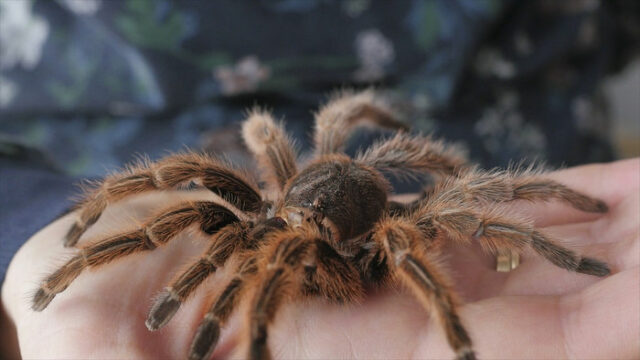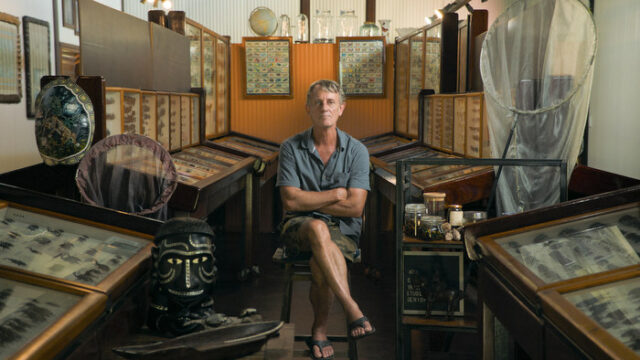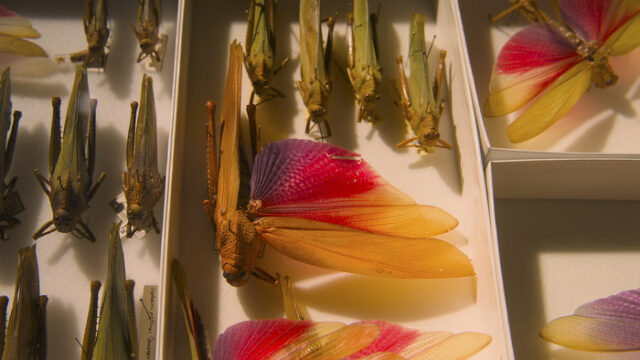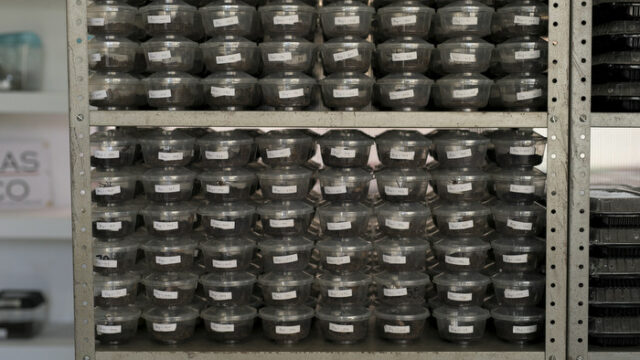
Read on for our in-depth interview about the new IMDb TV’s documentary series Bug Out with director Ben Feldman, DP Jen Schneider and producer Marc d’Agostino.
Amazon-owned AVOD streaming service IMDb TV recently launched the bingeable original true-crime docuseries Bug Out, a four-part whodunnit investigating a Philadelphia insect heist and the shadowy web of the international bug trade. Remarkably, lawyer-cum-documentarian Ben Feldman, with the help of Brooklyn-based production company The Cinemart, landed an original streaming deal on his first try out of the gate.
Ben, DP Jen Schneider, and Producer Marc D’Agostino answered my questions about the making of Bug Out, from nascent idea to finished product. What follows is a blueprint for how you, too, could potentially realize your own dream to create a hit docuseries.
Ben Feldman: I had been working as a lawyer in Philadelphia and wanted to try my hand at making a doc. So I was on the prowl for a story. I knew that without credits or experience, I wouldn’t be able to compete for larger stories attracting multiple filmmakers vying for access. I also didn’t have the resources or time (I was still working full-time as a lawyer) to travel across the globe in pursuit of a story, so it had to be semi-local.
No one really dug into the story
When the bug heist happened in summer 2018, it did briefly make national news, but really only as a headline. No one really dug into the story. After reading the headline, I thought that there must be more to a story like that. It also seemed to check a lot of boxes in terms of having a compelling visual component (bugs & a quirky museum). And, it involved a unique subculture that most people don’t know about. That was all enough to pique my interest and then when I set up my first meeting with John [Cambridge] and he started filling me in on the backstory and all the conflict, I felt confident that there was a film here.

Characters are perhaps almost as important as story, and the real life characters in your series seem to have jumped straight out of central casting. Did you have any idea of the richness of the characters before digging into the story? Did the characters shape how you told the story?
Ben Feldman: The initial feedback we got about the project was that the characters were very rich. We knew we had discovered an interesting world of bug collectors and although one might think they all fit a similar mold, that really didn’t seem to be the case. This was a pretty diverse and interesting cast.
One thing I learned is the importance of being open to finding new characters in your story. When we were doing a scout at the museum for our very first shoot for the sizzle, Kevin, an insectarium intern, approached me and said because he was 17 when the heist happened, no one had interviewed him about it, but he was present for the whole story and knew what really happened. I asked him to tell me what he knew and kind of filed him away as a secondary or tertiary character. Then a key interview canceled the night before our shoot and scrambling to fill the schedule, I asked Kevin if we could interview him. Kevin ended up being a standout and a fan favorite as a comedic counterweight to some of the more solemn characters.
I learned… the importance of being open to finding new characters
In terms of having characters define the story, when we landed the Philly detectives we were able to reshape the story along the lines of their investigation and the twists and turns they encountered. They were also so quintessentially Philly cops, their voices really helped place our story in Philadelphia and not just within the walls of the museum.

Can you give our readers a glimpse into your project development process, e.g. pitching, funding, budgeting, pre-production, etc.?
Ben Feldman: This being my first project, a lot of the development process was me fumbling around in the dark trying to figure out how to move a project to the next stage. As my first film, I knew the sizzle would have to prove my skills as a director with high production value and editing, in addition to having a great story to tell and the ability to tell it well. So I self-financed a 3-day shoot and then worked with an editor for 10 days on the sizzle. I then tried to enter the sizzle into a few pitch festivals but was rejected by them.
I had concurrently also sent out some cold emails to production companies
However, I had concurrently also sent out some cold emails to production companies whose work I admired. Most didn’t respond, but a few did, and The Cinemart (Amazon’s LuLaRich, Netflix’s The Pharmacist, Hulu’s Fyre Fraud) was enthusiastic about the story and shopping it. Partnering with an award-winning production company of that caliber and getting a deal with Amazon Studios for a 4-part series on IMDb TV was candidly light-years beyond what I had dreamed for this project. I’m so incredibly grateful for The Cinemart and IMDb TV’s guidance and confidence in me as a director.
Pre-production was very limited because we had a tight turnaround to deliver the series. Fortunately, by that point I had been researching and following the story for a couple years. I knew most of the characters we wanted to interview and knew the aspects of the larger bug world that I wanted to cover, too.

Ben Feldman: This is where having an awesome team makes a huge difference. We had great archival producers on the project who had experience requesting documents and finding archival. Also, our showrunner, Mike Gasparro who had helped land interviews with Billy McFarland and Jacqueline Cleggett on other shows, was instrumental in securing some difficult interviews for us.
It’s equally important to know when to give up
Luckily, I had also submitted FOIA requests early on in my initial research of this story. Some of those requests took years to be addressed and some of them are still pending. Knowing the process and knowing which requests can be expedited is important. But, it’s equally important to know when to give up on one specific request. We were frustrated when one agency produced interrogation video and blurred the entire person being questioned, rather than their faces, making the video unusable. After some back and forth, it was important to let it go and move on. In the end, the recre[ation] we shot in the actual interrogation room worked much better.

The investigation of essentially a local Philly story took you all the way to a remote location in Australia. Were you expecting that from the get-go, or did the need to travel abroad only become apparent as you delved into the subject matter? How did you manage the complexities of an international production?
Marc D’Agostino: We knew early on that this production had a global scale and that travel would be necessary because the illegal (and legal) bug trade is a global enterprise. We knew we wanted to tell stories that were related to the Philadelphia heist, but open a window into a big world filled with amazing characters for the audience. Ben happened to encounter this bug museum in Australia while on vacation there in 2019. It turned out to be a truly great find. He met Steve Lamond, who knew of the story in Philadelphia and had invaluable insight into the general insect trade and how and why a crime like this might take place.
We knew early on that this production had a global scale
That said, most of our production took place during the COVID19 pandemic, and no one was allowed into Australia. Add to that the fact that there is barely cell phone service in that part of the country, and yeah… it was complex. Really it was a feat of good communication and good connections. We hired an amazing crew in Australia, and this is where the experience and reach of The Cinemart really helped. They knew who to call. Also in a bit of kismet, Ben and I know an independent producer who had returned to his home in Australia to ride out the pandemic, so the team was led by a personal friend and filmmaker who Ben and I really trusted.

Ahead of the shoot, we were able to share some of what we already had in the can and discuss look and feel, the tone – really everything we had established for the shoots in Philadelphia. It became like a show within the show from budget to planning to staffing to execution. Ben remotely checked in multiple times a day as the [Australia] crew shot with the Lamonds to direct from afar as much as possible. Not being there in-person is not ideal, but the crew was awesome, and we love the work they did.

Fortunately, we were able to travel to Guadalajara, Mexico, and work in-person with Rodrigo, who breeds tarantulas to combat the illegal trade. The logistics when you’re traveling get complicated. And I’d just say to new filmmakers who may travel internationally to shoot – there’s a lot that goes into it. From finding the right local people to work with, to the carnet and other documents, to balancing the elevated costs because of flights, lodging and food, it’s a big producing task.
The single most important thing you can find is the right point person
The single most important thing you can find is the right point person – a fixer – who is local to the area. We had a great local field producer, Rogelio, who I worked with extensively ahead of the shoot to budget it, get the local crew hired, gear rented, find us a driver, map out our transportation, and translate. I think to succeed it has to be a harmonious partnership between your production and local talent with a lot of pre-planning.

Can you talk about your camera and lens choices, and what motivated them?
Jen Schneider: Our camera packages across the two years of filming were largely determined by budget and availability, with my Amira pairing up with various Canons owned by Marc and Ben. To make the look consistent across camera formats, I usually went with Leica Summicron-C T2 primes for portraiture and interviews because we wanted to capture in fairly low-light conditions inside the insectarium during construction, and also because I like the way those lenses render faces with a touch of pull back on the face – a bit of character that’s still subtle. For action sequences and b-roll, we went with Angenieux EZ-1 zooms.

The departure from typical rule of thirds interview framing was refreshing, e.g. center, profile, low angle, etc. Was that mostly intentional, or partly due to location limitations and the like?
Jen Schneider: The angles and framing were definitely intentional. The look Ben wanted for this true crime story was a moody, ‘‘ripped from the headlines’ kind of pulp fiction feel. But we also wanted to keep it light and fun – at times the show’s a comedy in a true crime wrapper. So I wanted the interviews to feel dynamic to maintain the energy of a whodunnit, but I also wanted to lean into the quirkiness of each character. The off-kilter frames were about creating movement, but also a kind of visual tableau that positioned each character in a relationship with their backgrounds – which production designer Lauren Becker rendered brilliantly as little backstories from one character to the next.
The off-kilter frames were about creating movement

Jen Schneider: This is partly about the noir look we were going for, and partly just my personal preference. I like to introduce a spicy hit or two to break up the perfection of interview lighting, just a small intrusion here and there to give a sense of change or movement or the outside world breaking into the scene. I try to tell a little story with these, but sometimes it’s purely formal – to get a white reference in to offset some big negative space.
I like to introduce a spicy hit or two to break up the perfection

Often when we think of documentaries, we think run n’ gun, get in and get out. But in many instances, it appears elaborate production design went into the staging of the interview locations. If so, what considerations did that necessitate in terms of crew, budget and timelines?
Jen Schneider & Marc D’Agostino: Insofar as the budget is a statement of storytelling priorities, we definitely wanted to prioritize the look of the interviews. Scouting the spaces our characters inhabit, we saw an opportunity to express a whole axis of meaning, and we wanted to take advantage of that. We wanted the interviews to be little worlds that our characters inhabit during the interview. In smaller-budget productions, especially docs, production design is often overlooked – you sort of say “well, we can do it ourselves” and the director, DP and others get tasked with this incredibly important and difficult job. But we knew we needed a dedicated artist to lead that, and so did the folks at The Cinemart who recommended we devote ample resources for this department and introduced us to Lauren Becker, our incredible production designer.
In smaller-budget productions, especially docs, production design is often overlooked

We drew inspiration from 19th century entomology and laboratory drawings, as well as modern-day paraphernalia like posters for bug fairs, to augment the existing spaces. The primary interview with John Cambridge takes place in an actual room in the Insectarium that was recently built as a “mad scientist lab.” Through rearrangement of existing objects and great use of light and camera position, you get this off-kilter feel – the whole thing feels precarious and uneasy, and that was perfect for the progression of John’s story.

Other times we started in a blank studio and built it from scratch, which impacts not just material costs but schedule in a major way. The time it takes to bring in everything – from Lauren’s own lizard, to the shelving, furniture, posters and plants – impacts call times, the coordination of crew on set, and transportation (as our wonderful production coordinator Jakkie Krinick can attest). There were days Lauren showed up in a car by herself with a few objects, and other days when it was a large Uhaul and two assistants.
It’s maybe more common on a fiction set to do it this way
It’s maybe more common on a fiction set to do it this way, but I’m seeing it more and more in documentaries and I think, in the end, it is so worth it. Lauren’s eye, her planning and her acquiring of materials for the interviews, elevates every frame.

Documentaries generate tons of footage. Can you discuss your field, post and backup storage strategy?
Marc D’Agostino: On set we used ShotPut Pro to transfer the card media to a master drive and a backup at the same time on a MacBook Pro laptop. We used SSDs which are a little pricier but are fast and give you more peace of mind than spinning disks. After a card left the camera and got downloaded, there was never a time the footage wasn’t in at least two places, confirmed by the software and with a spot check of the downloaded shots themselves.
We didn’t have budget for a loader and DIT, so we usually had a Second AC who was doing double duty as a loader and media manager, and we had an amazing camera department who really hustled to do that. I panic every time a card is initialized, but we had a really great team, so it made me rest easy.
I panic every time a card is initialized
It’s worth noting that prep is key because we shot long interviews and long days of vérité. Having a handle on transfer times and capacity of all the pieces involved is important so you have enough card space to keep rolling while downloading and not miss a beat. Our DP, Jen Schneider, and the camera department always thought ahead when we needed more card space on set, and we occasionally rented cards to make sure we maximized the day. It’s a small cost with huge benefit.

At the end of a production block, I would hold onto the backups and FedEx the master drives to The Cinemart, the production company in NY, and they transferred everything to a bigger drive system there to house all the data for the show and create the remote editing workflow. The entire show was offlined remotely with Avid stations shipped to our story producer Ian, myself, our director Ben, and the editors and AEs.
COVID really changed a lot for the editing process
We worked with a third-party vendor who provided a secure system that was fast enough for everyone to be working with the same footage at the same time. We were able to access all the footage that the Assistant Editors had organized, transcoded, and transcribed and work with it from our home offices.
COVID really changed a lot for the editing process; I’d never done it like that before where almost nothing was local. It was a great lesson in problem solving; the tech isn’t flawless at this point, but I think it opens up new avenues for collaborating across distance in the future.

How did you approach capturing sound for your project?
Marc D’Agostino: I think the honest answer to this question is, to get great audio, hire great people. Jackson Derbish and Matt Martin were our primary field mixers, and they know the craft so well. For more on-the-fly stuff, they know the dance with the camera. They understand where to be with the boom to get clean audio – always just out of frame – but how to step and move to avoid interfering with the cameraperson.
To get great audio, hire great people
Redundancy is key – they’ve always got at least a boom and lav recording at the same time so that when one is not perfect, the other can replace it. They would also go back and record a little wild sound for something we might want to emphasize in post, like footsteps, a door opening, an object being placed down. They’re experienced enough to know what you’re going to need and want in post, and they were tracking with the story so they could see it taking shape in their minds.

They also know where to compromise and where you cannot. For example, in each of the interviews, we wanted one of the angles to be very wide – wider than is conventional – to really let the space and art in the shots create meaning and context. This makes getting a shotgun microphone into a good position basically impossible because it has to be so far away from the subject to remain out of the shot, it can’t record quality sound.
Redundancy is key – they’ve always got at least a boom and lav recording
In the end, we decided to drop the mics into an ideal recording position and shoot with them right in the frame. Then we would remove the mic to shoot static plates. This allowed us to matte out the microphone in post-production. We get the wide frames we want, and as long as the camera doesn’t move at all, we can erase the boom later.

It took some planning and patience because if the sun is a light source in your shot, it’s going to move. So we had to get plates periodically over the course of an interview, as the sun moved, so the plate would blend seamlessly at any point in the interview. This takes a bit of extra time, but we all knew we couldn’t rush it, and it worked really well — the show sounds great and we got what we wanted from the visuals as well.
Sound in an interview is absolutely as important as the visual
Sound is one of those things that is often thought of as second to the picture. But when you watch a doc, most often the interview audio isn’t [in] sync with image – it’s over B-roll, recreation or archival material. So the sound in an interview is absolutely as important as the visual. In documentaries of this kind, the voice carries the story to a huge degree, and having that be clean, warm and perfectly audible keeps the viewer in the story. And in docs, you can’t do that in post; you’ve got to capture the moment as it happens.
Thanks to the Bug Out crew for cluing us in on the making of their docuseries. What do you think of their methods and work flow? Any surprises? Sound off in the comments below before bugging off!
























